FOUNDATION TRANSCRIPT - Media Education Foundation
FOUNDATION TRANSCRIPT - Media Education Foundation
FOUNDATION TRANSCRIPT - Media Education Foundation
Create successful ePaper yourself
Turn your PDF publications into a flip-book with our unique Google optimized e-Paper software.
MEDIA EDUCATION<br />
<strong>FOUNDATION</strong><br />
<strong>TRANSCRIPT</strong><br />
PLAYING UNFAIR<br />
THE MEDIA IMAGE OF THE FEMALE ATHLETE<br />
Challenging media
PLAYING UNFAIR:<br />
The <strong>Media</strong> Image of the Female Athlete<br />
Executive Producer: Loretta Alper<br />
Co-Producer and Editor: Kenyon King<br />
Executive Director: Sut Jhally<br />
Featuring interviews with:<br />
Pat Griffin University of Massachusetts; Author of Strong Women, Deep Closets<br />
Mary Jo Kane Professor, University of Minnesota; Director of Tucker Center for<br />
Research on Girls & Women in Sport<br />
Michael Messner University of Southern California; Author of Taking the Field<br />
<strong>Media</strong> <strong>Education</strong> <strong>Foundation</strong> © MEF 2002
INTRODUCTION – The Best of Times and The Worst of<br />
Times<br />
[News voice-over] Is the American public ready to embrace professional<br />
women’s teams and the image of a tough, physical, female athlete?<br />
MARY JO KANE: As we enter a new century, we are in what I call the Best of<br />
Times and the Worst of Times with respect to media representations of female<br />
athletes. There has been both widespread acceptance and movement of women<br />
in sport that was unheard of thirty years ago, and at the same time there’s been<br />
an increasing backlash about their success and their presence.<br />
MICHAEL MESSNER: I think not too long ago, it was very easy to equate<br />
athleticism, strength, physical power, with men, and by contrast to think about<br />
women as weak, as supportive for men, purely as sexual objects. Now that<br />
landscape as changed somewhat with the tremendous growth of girls and<br />
women’s sports.<br />
[Sports commentator] There’s Rebecca Lobo with a jumper!<br />
MICHAEL MESSNER: Everybody has the opportunity to see strong, powerful,<br />
physically competent, competitive women and I think that really challenges that<br />
simple gender dichotomy that we used to take so much for granted.<br />
PAT GRIFFIN: Sport is not just a trivial activity for fun. It has real, deep cultural<br />
meaning in this society. And I think that to challenge that meaning in terms of<br />
what it means to be a man in this culture, by inviting women in and<br />
acknowledging that women are also athletic and muscular and strong, is a real<br />
challenge to that cultural norm that we live in.<br />
MARY JO KANE: There is a cultural assumption that I think persists even to this<br />
day, that because of the definition of masculinity and sport, part of the birthright<br />
of being male in this culture is owning sport. You own sport. As women move into<br />
this once exclusive domain of male power and privilege and identity, there’s been<br />
a tremendous backlash, and a desire to push back, and either to push women<br />
out of sport altogether or certainly to contain their power within in and keep them<br />
on the margins.<br />
2
TAKING THE FIELD – The Impact of Title IX<br />
MARY JO KANE: Title IX is federal legislation, civil rights legislation that was<br />
passed in 1972 by the federal government. The legal piece of the law and the<br />
spirit and the intent of the law is to ensure that in educational institutions, females<br />
will have the same opportunities as will males.<br />
MICHAEL MESSNER: Girls now believe that they have a right to play sports and<br />
they’re surprised when they come up against barriers that say “you can’t do this”<br />
or “the boys have this field and you can’t use it.” And they’re quite ready and<br />
willing to start fighting because they see that that’s just patently unfair.<br />
MARY JO KANE: The way that I like to think about Title IX in terms of its impact<br />
is that in one generation, we have gone from young girls hoping that there is a<br />
team, to young girls hoping that they make the team. It is only because of Title IX<br />
that young girls today have a sense of entitlement to sport.<br />
[TV interview: Rebecca Lobo] Title IX is the integral reason we’re here. I mean<br />
college basketball wouldn’t have reached this level of popularity without Title IX,<br />
without universities being forced to implement Title IX.<br />
MARY JO KANE: So I think the issue of whether or not women should be<br />
allowed to play sport, which was very much in play pre-Title IX, that question has<br />
been put to rest. There’s too much of a critical mass now to push women out of<br />
sports altogether. So now the question becomes what will that participation look<br />
like?<br />
3
OUT OF UNIFORM – The <strong>Media</strong> Backlash Against<br />
Female Athletes<br />
MICHAEL MESSNER: If you just watch the sports news, and you just watched<br />
ESPN, and if you just picked up Sports Illustrated Magazine for your main print<br />
source of information about what’s going on in the sports world, it would be easy<br />
to continue to conclude that there is no women’s sports happening.<br />
MARY JO KANE: Women are significantly underrepresented with respect to<br />
amount of coverage, even though women represent 40% of participants<br />
nationwide in terms of sport and physical activity. What all the studies indicate is<br />
they represent about 3-5% of all the coverage. So we give viewers a very false<br />
impression if you just rely on the media, that women simply aren’t participating in<br />
sports in the numbers that they are.<br />
MICHAEL MESSNER: Over the course of a decade that we were doing research<br />
on the coverage of women’s and men’s sports, our dominant finding was how<br />
much the coverage of women’s sports had not changed. About 5% of the airtime<br />
was given to women’s sports. In our most recent study, ten years later that had<br />
gone up to about 8%, which is still miniscule. I mean it’s really a tiny increase in<br />
over ten year period in coverage of women.<br />
[NBC News] They are very excited. The NBA playoffs have arrived and while the<br />
Knicks are dominating…<br />
MICHAEL MESSNER: You set the tone and make a statement about what’s<br />
most important and what the key happenings of the day were with your lead<br />
story.<br />
[NBC News] a big night coming up in sports as the Islanders…<br />
MICHAEL MESSNER: What we found is almost always the lead stories were<br />
about men’s sports. They put a lot more production value into the men’s<br />
coverage. There’s tape, there’s graphics, there’s interviews and so forth.<br />
[ESPN promo] June heats up on ESPN.<br />
MICHAEL MESSNER: When women do kind of peak into the frame, though, it’s<br />
usually in ways that are mostly dismissive or disrespectful.<br />
[ABC News Channel 7] Finally, a hearty erin go bra to my countrymen andwomen<br />
out there, and in your honor we have a little Erin Go Bra-less.<br />
MICHAEL MESSNER: In our study, one of the longest stories that was done on<br />
the sports news for instance was on a female nude bungee jumper on St.<br />
4
Patrick’s Day who had painted her body green and jumped off of a bridge and<br />
they did a very long story on this – on the sports – meanwhile ignoring all the<br />
sports women had been playing that day: a major golf tournament and so forth.<br />
[ABC News Channel 7]<br />
--That’s wonderful; do we have to slow that down?<br />
--That was amazing, I’ll remember it forever.<br />
--…And so will we.<br />
MICHAEL MESSNER: Well we all know that news isn’t totally objective, but it’s<br />
supposed to be a picture of what happened today in the world.<br />
MARY JO KANE: What we know in terms of the data is that women athletes are<br />
significantly more likely than male athletes to be portrayed off the court, out of<br />
uniform, and in these hyper feminized roles. The thing that we infrequently see is<br />
images of women athletes as athletes. I think we need to talk about why that is<br />
and who benefits from not seeing women athletes as athletes.<br />
PAT GRIFFIN: Who’s controlling the images that we see in the media, and I think<br />
particularly if you look at sports media, by and large, the decisions about what<br />
images are portrayed, what images are used, who gets coverage, are still made<br />
by men. They’re part of a culture that sees women in a particular way. And so I<br />
think they prefer to see women athletes portrayed in a more feminine way, it’s<br />
more comfortable.<br />
MICHAEL MESSNER: When television does cover women’s sports, they’re most<br />
likely going to cover women’s tennis, and during certain seasons and certainly<br />
during the Olympics, women’s figure skating. There’s a traditional equation of<br />
femininity with tennis and figure skating that makes some sports commentators<br />
more comfortable with covering them – they fit more in their own ideological<br />
frame about what women are supposed to look like and how they’re supposed to<br />
act.<br />
There’s still a tendency, we found, in the play-by-play coverage of tennis to call<br />
women athletes more often by their first names, as though there’s some sort of<br />
familiarity that the commentator has with them.<br />
[Tennis commentator] … to counter Jennifer’s return.<br />
[Tennis commentator] … you just never know which Amelie’s going to show up.<br />
[Tennis commentator] … Monica, trying to hang on, but Serena’s serve…<br />
MICHAEL MESSNER: And to call men athletes by their last name or by their last<br />
and first name.<br />
[Tennis commentator] …and Ruzesky takes the game…<br />
5
[Tennis commentator] … Agassi, through to the semis, and coming off his<br />
French Open win.<br />
MICHAEL MESSNER: People who work in an office, the boss will call the<br />
secretary by her – or his, if it’s a male secretary – first name, and the referent the<br />
other way is always “Mr.” or “Mrs.” or some title.<br />
PAT GRIFFIN: I think what’s going on is we still have a lot of cultural anxiety<br />
about strong women and what that means about them as women. And until we<br />
can sort of move much further, as a culture in opening up the boundaries for<br />
what we consider to be OK for girls and women in sport, we’re always going to<br />
have that ambivalence there.<br />
MARY JO KANE: As we went into the women’s World Cup soccer, nobody knew<br />
who Brandi Chastain was. We knew who Mia Hamm was, but we didn’t know<br />
who Brandi Chastain was. We know who she is now.<br />
[Newscaster] World Cup hero Brandi Chastain, throws the first pitch – tank top,<br />
no sports bra.<br />
[ABC News Channel 7] And uh, Brandi did keep her shirt on, but did take a<br />
sweater off, during warm-ups.<br />
[ABC News Channel 7] It was announced Nike will exploit Brandi Chastain’s<br />
strip tease by attaching her to a line of sports bras.<br />
MARY JO KANE: It immediately got turned into “Brandi Chastain took her shirt<br />
off,” rather than “what fabulous athletes these women are!”<br />
MICHAEL MESSNER: How many times did we see images of Jenny Thompson<br />
actually swimming in Sports Illustrated? But when she posed for Sports<br />
Illustrated in that way, we saw her and now we know who she is.<br />
MARY JO KANE: What got taken up in the press and the public discourse<br />
wasn’t who Jenny Thompson was and what she’d accomplished as a great<br />
swimmer, an Olympic swimmer, but what did it mean to have Jenny Thompson<br />
take her shirt off?<br />
[Montage of images of female athletes and non-athlete models]<br />
MARY JO KANE: And the images that you see of women being physically<br />
powerful and strong and contrast that to the images of women athletes as little<br />
sex kittens, it’s an enormous difference. And it is such a powerful contrast that I<br />
would argue that is exactly why those images are suppressed. Because sport is<br />
all about physical, emotional, and mental empowerment. And so what do you do<br />
with all these women who are becoming great athletes and learning the lessons<br />
6
of empowerment and self respect and pride that you get from participating in<br />
sport? How are you going to keep that force at bay? And one way that you do<br />
that is to do a very time honored and tested mechanism of keeping women’s<br />
power at bay and that is to sexualize them, trivialize them, and marginalize them.<br />
There are more and more images of women athletes that bear alarming<br />
resemblances to soft pornography. What you see is an emphasis, not on their<br />
athleticism and their athletic achievements, or their mental courage and<br />
toughness, but on their sexuality, their femininity, and their heterosexuality.<br />
So what better way to reinforce all of the social stereotypes about femininity and<br />
masculinity than to pick up Sports Illustrated or Rolling Stone or Maxim or Gear<br />
and see an image of a female athlete, not as strong and powerful but as<br />
somebody that you can sexualize and feel power over.<br />
I don’t think that there’s a more overt example of that these days than in the<br />
world of professional tennis in the image of Anna Kournikova. She has the most<br />
corporate sponsorship of any professional female athlete and it is not because of<br />
her athletic competence because she is as of this date, still has never won any<br />
singles tournament, let along a Major.<br />
PAT GRIFFIN: What it says to me is that an athlete’s sexual appeal quotient is<br />
much more important than her athletic ability quotient and her athletic<br />
accomplishment quotient. And it’s very difficult to imagine the same kind of thing<br />
happening in men’s tennis – a player who has never won a major tournament<br />
getting the kind of attention – media attention and endorsement in terms of<br />
money that Anna Kournikova gets. And I think that as long as that’s possible, it<br />
really gives us a pretty good gauge of what are the important things in women’s<br />
sports.<br />
MICHAEL MESSNER: One of the new things over the last several years is there<br />
definitely is more media sexualization of men and men athletes in particular. Men<br />
are being viewed as sexy, mostly because of what they do. Of course they have<br />
to look good, but they’re viewed as sexy primarily for what they’re doing on the<br />
court or on the field, how good an athlete they are, how powerful they are, how<br />
they move when they play. Women are being viewed as sexy not for what they’re<br />
doing on the court or for what they’re doing on the field, but for how they look and<br />
what they wear off the field and how they pose off the field, and that’s the key<br />
difference.<br />
[ESPN: World’s Sexiest Athlete] The world’s sexiest athlete? Anna Kournikova,<br />
hands down. Have you seen the billboard of it? That explains enough.<br />
Kournikova: All athletes are entertainers. As long as people like what they’re<br />
seeing, they’re going to keep coming back, so I think that’s good.<br />
7
PLAYING ALONG – Empowerment or Exploitation?<br />
MARY JO KANE: It’s not just how the media portray women athletes. It’s how<br />
they are promoted and how they portray themselves. They simply feed into and<br />
keep the engine going of the way in which the media portray women athletes.<br />
[Entertainment Tonight!: Brandi Chastain interview] It was something that I’m<br />
glad I did and if it got attention for soccer, then good.<br />
MICHAEL MESSNER: Those are paradoxical images that both suggest<br />
empowerment for women and suggest that this media is still trying to frame<br />
women in conventionally sexualized ways. And I think that plays into very easily<br />
the idea that I, as an individual, need to feel empowered or do feel empowered<br />
by taking off my clothes and posing and getting myself into a major national<br />
magazine and maybe getting some endorsements.<br />
PAT GRIFFIN: There are other women that I’ve talked to – young women – who<br />
see this in a real different way. They don’t really see that as compromising or an<br />
expression of concern about how people see them. They just see that as – “that’s<br />
just my individual way of expressing myself.” And I think that certainly could be<br />
true for a certain number of them. But what I always want to say to them is it’s<br />
important to look at the larger picture of pressures, that it’s not just about<br />
individual choice. That if you look at how women athletes portray themselves,<br />
and how they’re portrayed in the media, it’s a part of a much larger cultural<br />
expectation. Is this the kind of image that we want young girls who are interested<br />
in sport to aspire to? Do we want them to think that in order to be respected as<br />
an athlete, they have to strip?<br />
MARY JO KANE: And a very common retort is “what’s wrong with being<br />
portrayed as feminine?” and “we want to be portrayed as well-rounded” and<br />
“there’s nothing wrong with showing off our bodies. We’re proud of our bodies.”<br />
And on the surface, I think that all of those are very legitimate arguments. The<br />
problem that I have is that for women to show that they have strong and powerful<br />
bodies, it does not require them to take their clothes off. The way that those<br />
images get taken off is basically in terms of locker room titillation. It has<br />
absolutely nothing to do with men sitting around, saying, “Boy, I really respect<br />
them as fabulous athletes.” It’s about consuming their bodies for men’s sexual<br />
pleasure. So that in no way empowers them or is done as an empowering image.<br />
MICHAEL MESSNER: I don’t think you’d have near the amount of controversy or<br />
debate if a woman occasionally decides to pose half-clothed in front of a camera<br />
for Sports Illustrated or something. But it’s the dearth of coverage of women and<br />
the dearth of respectful coverage of women’s athletics in those major media that<br />
makes those images stand out so much and be so controversial.<br />
8
THE GLASS CLOSET – Homophobia in Sport & Sports<br />
<strong>Media</strong><br />
MARY JO KANE: Homophobia is in the bone marrow of women’s athletics, you<br />
simply cannot get around it.<br />
[ABC News] Billie Jean King, the undisputed Queen of Tennis. Last Friday,<br />
facing what is certainly the most serious crisis of her career, thirty-seven year old<br />
Billie Jean admitted she had had a homosexual affair with her former Marilyn<br />
Barnett.<br />
[NBC News] Billie Jean King’s contract to make television ads for ER Squibb<br />
Company is not being renewed. The New York Daily News quotes a company<br />
official as saying she was too strong a personality, that she was overpowering<br />
the product. He denied that the company’s decision had anything to do with Mrs.<br />
King’s disclosure of a lesbian relationship. The News says Avon Products is<br />
reviewing its connection with Mrs. King cautiously.<br />
MARY JO KANE: I think its pretty clear that if you’re a female athlete and you<br />
want corporate sponsorship, you’d better project a wholesome image. And part of<br />
that wholesomeness is the assumption that you are not lesbian, that you are<br />
heterosexual. So you’ll have a disproportionate number of images of women<br />
athletes with children, with boyfriends, with husbands, to clearly mark themselves<br />
as heterosexual.<br />
PAT GRIFFIN: Sometimes I refer to that as sort of the protective camouflage of<br />
feminine drag that women athletes and coaches feel sort of compelled to monitor<br />
in themselves and in others. Certainly it’s this need to reassure people – I’m an<br />
athlete, I may be a great athlete, but don’t worry, I’m still a normal woman.<br />
MARY JO KANE: The acronym for the professional golf tour is the LPGA, as in<br />
the Ladies Professional Golf Association and I think it has been widely known or<br />
feared for many years that the “L” stands for “lesbian.” The LPGA and the women<br />
who’ve played in the Tour have taken great pains to distance themselves from<br />
that lesbian image and to again, very overtly and explicitly identify themselves as<br />
heterosexual.<br />
[TV ad] Hey Laura Baugh, UltraBrite toothpaste would like to proposition you.<br />
Laura: Right here? On national television?<br />
MARY JO KANE: Jan Stephenson who was a well known professional golfer<br />
was part of an LPGA calendar – “we’re professional golfers by day but we’re<br />
really sexy gals by night.” A disproportionate amount of the coverage given to<br />
Nancy Lopez who’s one of the greatest golfers ever on the Tour was about her<br />
marriage to Ray Knight who’s a professional baseball player with the Mets, and<br />
9
her role as a mother. There were lots of pictures of Laura Baugh when she was<br />
pregnant and playing on the Tour. The LPGA rarely gets any media coverage<br />
and yet there was a lot of media coverage around “is she going to be able to get<br />
through the round and the tournament and not go into labor?” The media or the<br />
corporate sponsors or the women athletes themselves specifically identify<br />
themselves with the role of wife and mother, which clearly marks them as<br />
heterosexual.<br />
[ABC News] For Chris Evert this will be her nineteenth and last US Open.<br />
MARY JO KANE: In the late 1980s, one of the greatest professional tennis<br />
players this country has ever produced, Chris Evert, announced her retirement.<br />
Sports Illustrated chose to put her on the cover: “Now I’m going to be a full time<br />
wife.” They chose to portray her as somebody who was giving up her career to<br />
become a full-time wife. On the inside, with the profile, they had a pictorial<br />
chronology of Evert’s “career” in sport. This isn’t in “Bride Magazine” or in<br />
“Heterosexual Magazine” – its in Sports Illustrated, talking about her retirement<br />
as being a professional tennis player, and yet the focus, certainly in terms of the<br />
visual images you were given, was of Chris Evert as a heterosexual wife and<br />
mother.<br />
PAT GRIFFIN: The more we focus on women athletes as heterosexual and sexy<br />
and feminine, the more lesbians in sport become invisible. It’s difficult enough in<br />
many cases to be a lesbian in sport, but to be held up against that standard that<br />
is not about me – that sense of being made to feel as if I must be invisible for the<br />
sake of women’s sports, for the sake of not creating controversy – it’s a huge<br />
pressure, and it keeps us from really dealing with some of the key issues in<br />
women’s sports which have to do with heterosexism and homophobia.<br />
[ABC News] It has added to the torment she has long suffered, from the public<br />
acknowledgement of her homosexuality.<br />
Martina: It’s much easier being heterosexual, believe me. It’s much easier<br />
pretending.<br />
PAT GRIFFIN: There are heterosexual women in sport who are very much<br />
threatened by the idea that someone might think that they’re a lesbian, or would<br />
call them a lesbian. And lesbians in sport are very much concerned – and rightly<br />
so – about being discriminated against, if they’re identified in sport. And you put<br />
that together and it really drives a wedge between women in sport. And that<br />
wedge serves a larger social function of keeping women from forming alliances<br />
to really further women’s sport as a whole.<br />
[Tennis commentator] …I mean she came out and openly declared her<br />
sexuality and in team sports of course that would be suicidal – I don’t mean that<br />
literally, but I mean it would be a very, very hard thing.<br />
10
PAT GRIFFIN: I think it’s amazing to me that in the WBNA, there is not one<br />
publicly out basketball player. And yet we know that there are many lesbians in<br />
basketball as there are in any sport. But none of them have felt personally safe<br />
enough, or I think another factor is feeling like the league itself, the women’s<br />
basketball professional league, is safe enough to withstand the potential media<br />
scrutiny of acknowledging that there are lesbian players. You know, the weird<br />
thing is everyone knows there are lesbian players. So we have this strange sort<br />
of paradox of lesbians feeling that they need to hide, yet everyone knows that<br />
they’re there – I often call it the “glass closet.<br />
MARY JO KANE: The WNBA is very much aware that a large part of their fan<br />
base is lesbian. They’re a new league, they are struggling to survive. So they<br />
certainly don’t want to alienate any section of their fan base, especially one that’s<br />
so prominent and loyal. On the other hand, they take great pains to market<br />
themselves as a family-friendly entertainment venue. And so because of<br />
homophobia and cultural stereotypes, we see that there’s this contradiction on<br />
the one hand wanting to market yourself as family values entertainment, and on<br />
the other hand, what do you do with the fact that you have these lesbians in the<br />
stands?<br />
MICHAEL MESSNER: There are stars that were put forward to promote the<br />
league, were positioned as the “girl next door,” like Rebecca Lobo, a mother –<br />
Cheryl Swoops, or a fashion model – Lisa Leslie. And in doing that what they did<br />
was they pushed certain women forward as representing the league, who could<br />
exemplify what they saw as pretty conventional, heterosexual roles for women.<br />
MARY JO KANE: I think the struggle is, how do you show athletic competence,<br />
athletic strength, athletic power – beating up and beating down your opponent –<br />
in ways that don’t trigger cultural stereotypes about women athletes being too<br />
butch, being too manly, being too aggressive?<br />
[Basketball Coach Pat Summit] Get tough! Get tough!<br />
MARY JO KANE: In order for women athletes to be taken seriously as athletes,<br />
they have to be portrayed as competent, which in sports like basketball, by<br />
definition means being big, strong, tough, fast, powerful. You can’t have one<br />
without the other, and yet to equate them means to challenge every stereotype<br />
and construction of femininity and masculinity we have in the culture.<br />
11
FAIR PLAY – Women Athletes in Action<br />
PAT GRIFFIN: Masculinity and femininity are not natural things. You know, boys<br />
don’t pop out of the womb with a football in their arm, and girls don’t pop out with<br />
a doll. We have to be taught very carefully how we’re supposed to act to conform<br />
to those artificial expectations of masculinity and femininity. And to the extent that<br />
sport is very gendered in this culture – its one of the ways that masculinity and<br />
femininity are taught.<br />
MICHAEL MESSNER: One of the things that people haven’t really talked about<br />
that much though is that having more images of powerful women, respectful<br />
coverage of women’s sports, is also potentially very good for boys. Boys are<br />
growing up in a world where they’re going to have women co-workers, women<br />
bosses – the foundations for their views of women are being laid during their<br />
childhood. If what they’re seeing is a sea of imagery that still suggests to them<br />
that athleticism is to be equated entirely with men and masculinity and that<br />
women are there simply as support objects or as objects of ridicule or as sexual<br />
objects, that is helping to shape the images that boys have of women. I don’t<br />
believe that there’s a conspiracy in the media to say “let’s not cover women’s<br />
sports” or “lets make fun of women athletes,” but I think that especially sports<br />
desks and sports news people have not caught on to the fact yet that the culture<br />
has changed.<br />
PAT GRIFFIN: Well, I don’t think any social change happens in a nice, smooth<br />
sort of step-by-step path, onward and upward. If you look at any social change<br />
movement, whether we’re talking about the black civil rights movement, the<br />
women’s movement in general, the gay, lesbian, bisexual, transgender<br />
movement – when there are changes, there’s always a pushback. And so<br />
change sort of happens in that way, and I think that’s what we’re seeing here.<br />
MARY JO KANE: All I’m asking is, turn the camera on, and let us see what it<br />
looks like when women participate in sports. And what we’ll see is that they are<br />
terrific athletes who are enormously gifted and enormously committed to<br />
something that many people in this country love, and that’s sport.<br />
12


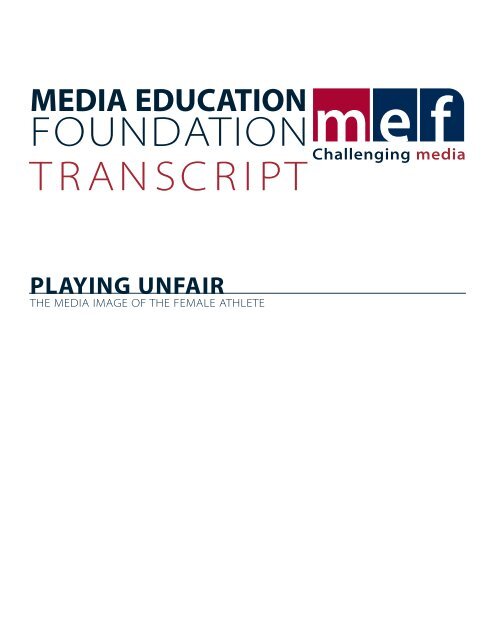

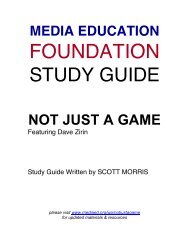


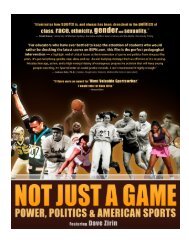




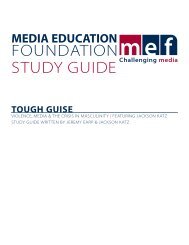
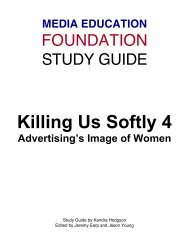
![Sext Up Kids [Transcript] - Media Education Foundation](https://img.yumpu.com/3099056/1/190x245/sext-up-kids-transcript-media-education-foundation.jpg?quality=85)